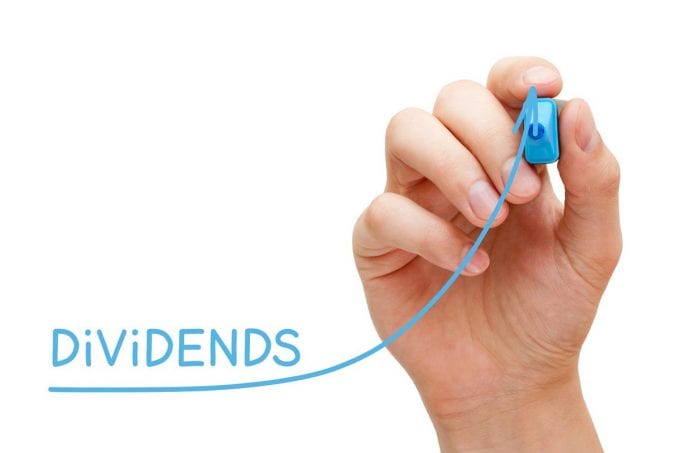Dividend investing can be considered a subset of the stock market. Dividends are received as profits from a stock that is owned by a shareholder. Of course, these dividends could be given in different forms like cash (which is most common) or in the form of additional stock. According to Ask Traders, financial market brokers allow investors to buy or sell stocks with dividends that are paid to shareholders after the residual profit is calculated into quarterly earnings.
Dividends are managed by the company’s board of directors. Depending on whatever the case may be, it is important to note that a company can decide to pay no dividends due to its performance. However, this is relatively rare and the number of shares each trader owns within a company will determine the dividend. A simple calculation of the dividends includes the number of shares multiplied by the dividend per share.
In certain companies, the profit is usually reinvested back into corporate ownership due to low earnings or based on agreed operations. In most cases, the company’s board determines the time when the dividends are paid and the time of payment is often at the end of the company’s fiscal year (which could be June, January, August, December or any other month).

There are different types of dividends: cash, stock, assets, special, common, or preferred. Cash is the most common type of dividend payout. Previously, the payments were usually made via checks that showed an overview of the payment. However, with the recent developments in online trading technologies, the payments are now paid via wire transfer. Stock payment is another option, however, this could be unfavorable if the share prices of the company in question are very volatile. The number of shares given is based on the stock ownership held by each shareholder. An asset that includes physical assets (such as parts of a real estate transaction) could be given to shareholders. However, this is a very rare practice.
Depending on the company’s decision as to when dividends are paid, there are special cases when dividends are not paid during the agreed time due to various reasons. Different options, warrants, or stock shares could be given under the terms of a new investment that is under the company.
So, if Company A just started or bought Company B, you can be given shares from Company B as dividends from your shares in Company A. Within each company, share buybacks are common, and they occur when a corporation wants to buy its shares in the open market. These strategies help increase earnings per share (or EPS), and eventually return cash returns to shareholders.

Companies within the oil and gas industry, banking and financial industry, healthcare and pharmaceutical sector and utility sector often pay their dividends regularly. However, with certain companies, they don’t pay dividends in most cases (such as some technology companies and startups). If they pay dividends, payments are sometimes conducted on an occasional basis. Dividends affect the market prices of a company’s stock in different ways, and this is especially true on the announcement date. Dividends are usually incorporated into the share price, and this affects the future cash flows of the company. In cases where the stock is paid as a dividend, the share price can drop (or rise) because the number of shares is slightly increased or reduced.
Often, certain shareholders try to drive up their dividends by buying more stock before the ex-dividend date. This is the date where dividends eligibility expires. Therefore, if you buy dividends after the ex-dividend dates, you will receive no dividends. Due to this, dividend trading becomes interesting. If a shareholder perceives that the profit isn’t going to be as much as he expects, he reduces his shares or completely sells it. And if he thinks the earning per share is much, he buys more shares to increase his earnings. Some people only invest in a company for dividends and without expecting much in terms of earnings growth.

If investors have a good understanding of how the company works, investors can make a trade before the stock’s ex-dividend date, and trade all shares right after the payment date. If you are all for the dividends, all you need to do is find companies that have performed well over the previous fiscal year and have a strong analyst outlook for the year ahead. If done well, these strategies could be a good soft income for anyone.
If you are looking at only the now, you must spend time researching the market. Dividend trading involves monitoring companies over a long period of time. Understanding why they have a good dividend-paying track record is important but seeing the underlying relationship for this also important. This relationship of understanding helps see whether the company is going to make that kind of dividend payment continuously in the future. If so, place your money. If not, find another dividend stock selection.
Pros: Dividend Investing
- Investors are often shielded from broader stock market volatility. In most cases, the movement of stock prices is very unpredictable and this is the reason buying shares for dividends is a safer option with low risks.
- Dividend investing is easier to predict given the history of the company. The variations in dividend payouts are rate and are often easy to know in advance.
- Dividend investing could be a steady source of income, especially with a widely diversified portfolio in place.
Cons: Dividend Investing

- There are usually limits to what is paid to shareholders via dividends. Oftentimes, the maximum percentage is 10% and this can be less than other stock investment types.
- As much as it is easy to select which stock can be profitable, it is important to know that these things easily can go south. There is no certainty or guarantee that the same dividends will be paid in the future.
- High rates could be very deceiving if the company has other plans for investments and dividends might be cut for those plans.
When it comes to financial markets, one could say dividend trading is probably one of the strategies with the lowest levels of risk. Therefore, if you are looking for a low-risk investment with a steady income, dividend trading might be the best way for you to accomplish your goals.









